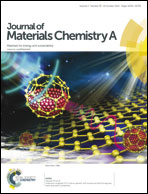Facilitating hydroxide transport in anion exchange membranes via hydrophilic grafts†
Abstract
Alkaline exchange membranes (AEMs) are a promising class of polyelectrolytes whose alkaline operating environment enables the use of non-precious metal catalysts in low-temperature fuel cells. However, their poor ionic conductivities, which are often an order of magnitude lower than traditional acidic membranes (e.g., Nafion), have limited their practicality. The performance problem can partially be ascribed to the poorly-defined morphologies of typical random copolymer AEMs, leading to tortuous ion transport pathways. Here, we show the ability to form nanoscale (5 to 10 nm diameter) anion transport channels by grafting hydrophilic poly(ethylene glycol) side-chains along a model benzyltrimethylammonium polysulfone-based AEM. Concomitant with the structure formation is a 100% increase in the IEC-normalized hydroxide conductivity from 20.2 mS g cm−1 mmol−1 to 40.3 mS g cm−1 mmol−1 as well as a 50% increase in the peak power density from 118 mW cm−2 to 180 mW cm−2 when incorporated into a fuel cell.


 Please wait while we load your content...
Please wait while we load your content...